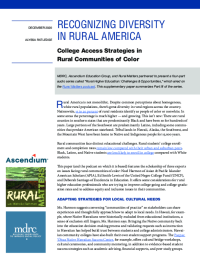Recognizing Diversity in Rural America
College Access Strategies in Rural Communities of Color

MDRC, Ascendium Education Group, and Rural Matters partnered to present a four-part audio series called “Rural Higher Education: Challenges & Opportunities,” which aired on the Rural Matters podcast. This supplementary paper summarizes Part III of the series.
Rural America is not monolithic. Despite common perceptions about homogenous, white rural populations, there’s great diversity in rural regions across the country. Nationwide, 15 to 20 percent of rural residents identify as people of color or nonwhite. In some areas the percentage is much higher — and growing. This isn’t new: There are rural counties in southern states that are predominantly Black and have been so for hundreds of years. Large portions of the Southwest are predominantly Latino, including some communities that predate American statehood. Tribal lands in Hawaii, Alaska, the Southwest, and the Mountain West have been home to Native and Indigenous people for 15,000 years.
Rural communities face distinct educational challenges. Rural students’ college enrollment and completion rates remain low compared with their urban and suburban peers. Black, Latino, and Native students are less likely to enroll in college compared with White students.
This paper (and the podcast on which it is based) features the scholarship of three experts on issues facing rural communities of color: Noel Harmon of Asian & Pacific Islander American Scholars (APIA), Ed Smith-Lewis of the United Negro College Fund (UNCF), and Deborah Santiago of Excelencia in Education. It offers some considerations for rural higher education professionals who are trying to improve college-going and college-graduation rates and to address equity and inclusion issues in their communities.
Adapting strategies for local cultural needs
Ms. Harmon suggests convening “communities of practice” so stakeholders can share experiences and thoughtfully approach how to adapt to local needs. In Hawaii, for example, where Native Hawaiians were historically excluded from educational institutions, a sense of exclusion still lingers, Ms. Harmon says. Bringing the Native community back into the education decision-making process and validating requests such as instruction in Hawaiian has helped build trust between students and college administrators. Hawaiian community colleges have also built their own student support programs. The Paepae ‘Ōhua Native Hawaiian Success Center, for example, offers cultural bridge workshops, cultural ceremonies, and community mentoring, in addition to evidence-based student success strategies such as academic advising, financial supports, and peer study groups.
In Mississippi, statewide rural business development funds have special set-asides to invest in historically Black colleges and universities, to build up entrepreneurship in southern Black communities, Mr. Smith Lewis says. Similar legislation to support rural communities has been introduced at the federal level.
Including local communities in the development of solutions
Educational strategies that consider the local context, needs, and desires of students are getting increasing attention. Advocates and college staff alike agree that for rural communities, it is essential to include community leaders, parents, and students in conversations about new interventions from the beginning, to identify barriers and potential solutions. This process ensures that the solutions developed have salience and relevance and appeal to the students and families they serve. This is especially important for communities of color, who often report feeling sidelined or patronized in education reform conversations. Including their perspective and then acting on it changes that dynamic, Mr. Smith-Lewis says. It’s about demonstrating the applications for student success to the community, he says, “not learning for the sake of learning.”
Piloting strategies that support the nontraditional or “post-traditional” college student
Each year, fewer and fewer college students fit the model of the “traditional” 18-year-old college student who lives on campus, attends school full time, is supported financially by parents, and has no significant external obligations such as children or employment. Ms. Santiago calls many rural students of color “post-traditional”: They are often older, commute into college each day from a long distance, may have family or child care responsibilities, and are almost always working at least part time. Rural colleges are developing unique supports to serve them. For instance, some colleges offer alternative course schedules that accommodate the seasonality of local industries such as farming, with breaks purposely scheduled during harvest weeks when students are unavailable for classes. Other colleges help students in distant parts of their catchment area connect with other students through carpooling agreements and provide gas money for drivers, so far-flung students can share the physical and financial burden of driving to campus.
Attracting and retaining faculty members of color
Many colleges are testing out ways to improve diversity efforts in faculty hiring and retention. For example, some colleges have changed their recruitment strategies to target Ph.D. programs that graduate more people of color from rural states, as those graduates may be more likely to take jobs in a rural area. To improve retention rates, some colleges have worked with community organizations to understand the racial climate in their town or county, with the goal of enhancing the quality of life for faculty members of color and their families. All three panelists agree that while faculty retention in rural areas can be an extra challenge, even incremental improvements can make a difference for students of color looking for mentors.
Addressing fears of “brain drain” or outmigration
Rural students of color often share that they faced skepticism from their families and communities when they said they wanted to go to college. There could be several reasons for this. Families may want their children to enter industries that have long been mainstays in their area, such as agriculture or mining. They may not see the value of higher education or the connection to 21st-century jobs, even fearing their children will face the same racism and exclusion in academia that past generations did. Perhaps most prominent across the country, however, is the fear that students who get a college degree will leave in search of better-paying jobs far from home — a rational concern given the modern history of outmigration from rural states. All three panelists say colleges and community organizations are working to address these concerns. They are drawing attention to the wider variety of careers available in the modern economy, even in rural areas, such as computer programming jobs that can be performed remotely. They are also educating students about changing local workforce needs, such as agriculture and manufacturing jobs that are increasingly relying on high-tech skills.
Thinking of rural students’ educational goals as community and economic development strategies
Worries about rural outmigration can also be offset by changing students’ views of their education. The panelists note that in many rural communities of color, the dream of a college degree is not just for students’ own goals but for their families and communities, too. Federal data show that rural young people are more likely to return to rural communities after time spent in a city for family and lifestyle reasons, as well as to bring ideas and business back home. Reframing the conversation to consider educational attainment as part of local economic development can help expand families’ perceptions of the value of a local college education and the careers available in their community. For tight-knit communities of color, this cultural context may support college-going rates.
Disaggregating data (especially for overlooked demographics)
Lack of reliable data on rural student outcomes continues to be an issue for college administrators trying to improve retention and graduation rates. At the same time, in many communities, the inability to disaggregate data masks disparities. Ms. Harmon notes that there is so little disaggregated data on Asian and Pacific Islander students that oftentimes, these underserved populations are not even noticed: When national data show that Asian Americans have high college-going rates, for example, the lack of statistics broken out by racial or ethnic subgroups means that lower college-going rates of groups like Native Hawaiians aren’t visible. Similarly, Native American and Alaska Native education outcomes often aren’t reported in the first place, making these groups invisible to practitioners and policymakers who would otherwise want to help them.
In addition to race and ethnicity, rural colleges may want to break out academic outcomes by distance from the school, as this is a common barrier to success. Colleges can start by simply asking students how far their commute to campus is. Being able to disaggregate data can help identify achievement disparities and elucidate ways to bring students up to parity with their higher-achieving counterparts.
Conclusion
Researchers are only beginning to understand the confluence of race and rurality. Many rural colleges are looking for ways to boost college enrollment and graduation rates, especially among groups who historically have been shut out of equal access and who continue to face academic and economic disparities. The ideas presented in this paper offer a jumping-off point for higher education professionals and policymakers as they strive to develop culturally relevant programs and strategies to serve rural students of color.
For more information:
Noel Harmon, APIA Scholars, https://apiascholars.org/
Deborah Santiago, Excelencia in Education, https://www.edexcelencia.org/
Edward Smith-Lewis, UNCF, https://uncf.org/
Alyssa Ratledge, MDRC, alyssa.ratledge@mdrc.org
Danielle Vetter, Ascendium Education Group, dvetter@ascendiumeducation.org
Check out the Rural Matters podcast to learn more about innovative programs serving rural communities.






